Open as PDF
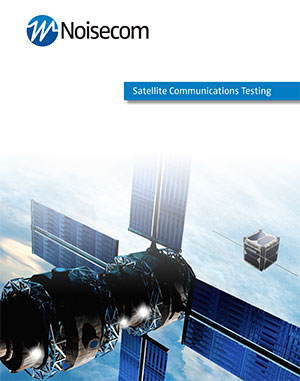 Traditionally, the satellite industry has relied on geosynchronous earth orbit (GEO) satellites that take years to build and require very expensive launches to deliver them to orbit. Latency issues due to the distance of these orbits limit the ability of these satellites to be used for real-time communications like voice or live video transmissions. New technology is driving a wave of innovations and an evolution to smaller micro-sats deployed in low earth orbit (LEO) with reusable rockets delivering multiple satellites at a time with a single launch vehicle reducing deployment costs. These smaller satellites are deployed in mega-constellation arrangements to provide voice, video, imaging and data to commercial and military clients with higher data rates and lower latency than legacy GEO deployments.
Traditionally, the satellite industry has relied on geosynchronous earth orbit (GEO) satellites that take years to build and require very expensive launches to deliver them to orbit. Latency issues due to the distance of these orbits limit the ability of these satellites to be used for real-time communications like voice or live video transmissions. New technology is driving a wave of innovations and an evolution to smaller micro-sats deployed in low earth orbit (LEO) with reusable rockets delivering multiple satellites at a time with a single launch vehicle reducing deployment costs. These smaller satellites are deployed in mega-constellation arrangements to provide voice, video, imaging and data to commercial and military clients with higher data rates and lower latency than legacy GEO deployments.
Industry predictions show that large numbers of LEO micro-satellites will be launched due to performance and cost benefits of using the new technology. This increase in the number of satellite uplink and downlink stations will require systems to be designed to reject real-world RF interference from other uplink and downlink transmitters, as well as constellation communications between satellites as part of the relay network.
Micro-satellites use new technologies based on broadband modulation and spread spectrum schemes to provide secure, high speed data services for uplink and downlink to earth stations, as well as critical inter-satellite communications using millimeter wave frequencies. Noisecom noise generators and sources are broadband devices available in microwave and millimeter wave frequencies to help test and stress the RF signal integrity of all communication links.
For over 30 years Noisecom has been designing noise generation devices and instruments for Carrier-to-Noise, jamming, multipath fading, satellite test and calibration across a wide variety of industries. Noisecom has a depth of experience unmatched in the industry and works closely with technical end users to find the right product for their application with both off the shelf and customized solutions. This experience and close links to customers and markets has led to the development of noise generators and broadband noise modules specifically designed for the RF signal paths in satellite applications up to 110 GHz.
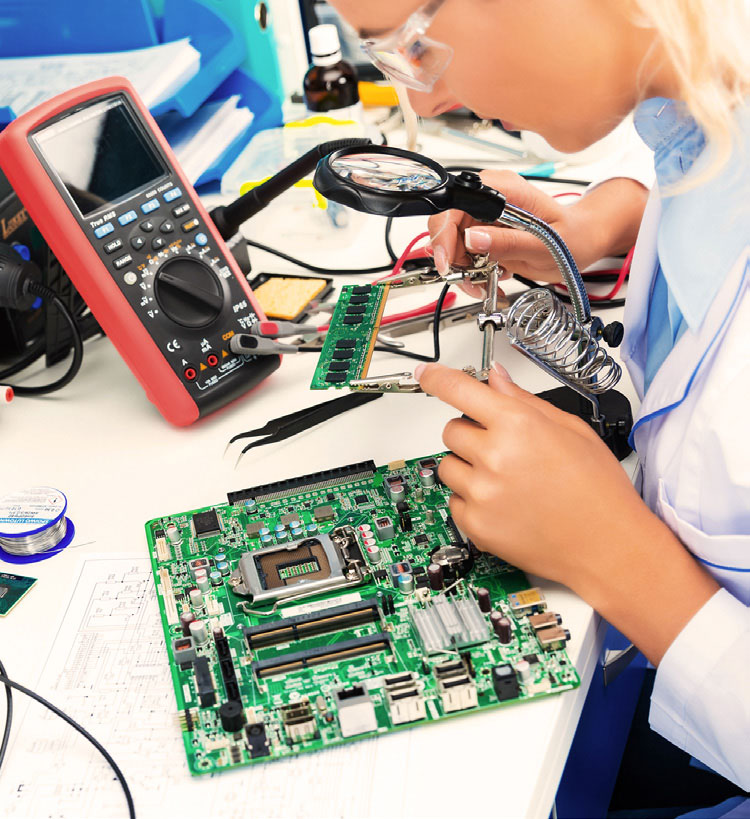 Customization
Customization
Each system is different and the set of RF interference challenges vary in every satellite deployment or communication link. This diverse range of unique testing requirements is why Noisecom carrier-to-noise generators and RF noise solutions are highly customizable. Generators and instruments can be designed for different noise power density, internal filtering, and remote control. Whether it is small modifications to frequency or power levels or a fully custom solution, Noisecom has a broad range of capabilities and solutions for every budget.
Receiver Sensitivity – Carrier-to-Noise Ratio Testing
Testing the performance of a satellite communications channel in the presence of noise and interference is critical, as a poor communications channel will limit the amount of data and range that can be communicated and the reliability of the communications. Modern modulation schemes significantly help reduce the impact of noise in the communications channel, but ultimately too much noise or interference can overpower the carrier and prevent the receiver from distinguishing it from noise. Carrier-to-noise (C/N) ratio is one of the most common parameters to test when determining the performance of a satellite communications channel. The more noise a channel can tolerate, the better the quality of the link, making the system more reliable.
Noisecom UFX7000A instruments provide a flexible architecture to create sophisticated noise signals enabling satellite system designers to test the unique characteristics of their RF uplink and downlink paths in the presence of noise. Precision components provide high output power and superior flatness while controllable attenuators, switches and filters ensure the right interference signal is being generated and then applied to test the system. The output from the UFX7000A is directly applied to the test signal allowing for full system performance analysis and stress testing to happen within existing test conditions, providing the full picture of how the system will perform in the presence of real-world interference.
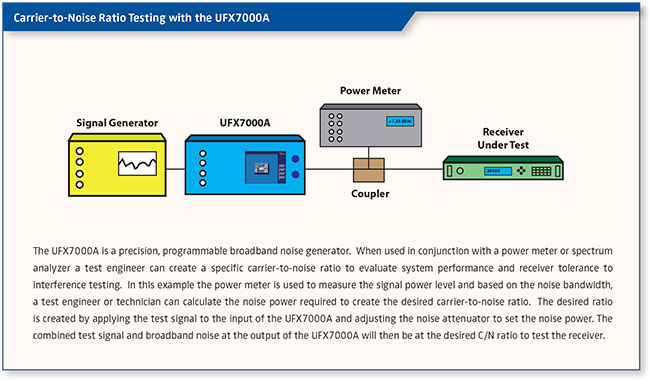
Receiver Testing – Carrier-to-Noise Ratio Generation
Carrier-to-noise ratio is one key parameter of receiver testing along with enrgy per bit-to-noise power density (Eb/No) and carrier-to-interference (C/I), combined key ratios like this give a full picture of what levels of interference or noise a channel or receiver can tolerate. Testing system performance for these different parameters and optimizing for desired performance levels is time consuming and error prone due to the manual trial and error process of measuring levels and resetting generators.
The CNG-EbNo instrument greatly simplifies satellite communications link testing by allowing engineers and technicians to simply enter a desired C/N, Eb/No or C/I ratio without the use of additional instrumentation such as power meters or spectrum analyzers. As an all-in-one measurement and noise generation solution the CNG-EbNo provides repeatability and reliability by eliminating the complexity of using multiple instruments to test receiver performance in the face of real-world noise or interference. Ratios like C/N, Eb/No or C/I are created by the instrument with use of an embedded power meter enabling the user to simply enter the desired ratio locally or remotely.
Often a multi-carrier transmission scheme is deployed in a satellite communications link. In these scenarios a system designer may want to test receiver performance at different C/N or C/I ratios at specific carriers as opposed to across the entire band. In this case the power meter embedded inside the CNG-EbNo is replaced with a spectrum analyzer. This internal change enables the power level of the carrier to be measured at a specific frequency and the corresponding C/N or C/I ratio to be set based on the incoming power level of any specific carrier.
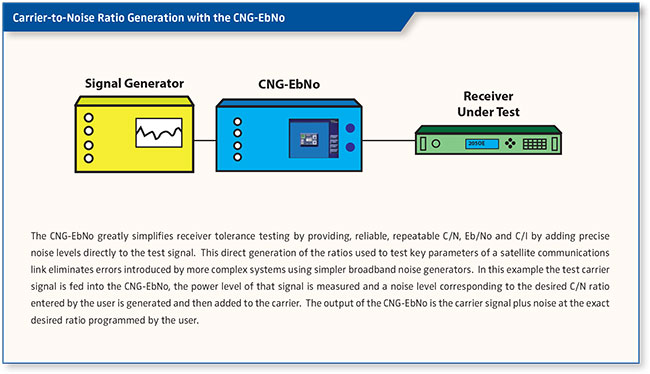
Amplifier Linearity – Noise Power Ratio
Performance of power amplifiers that amplify a number of carriers at the same time is tested using a Noise Power Ratio (NPR) method. Amplifier performance is important in a system as non-linearities will reduce the dynamic range of the communications channel by limiting the lowest power level of a signal that can be received erroneously. Noise power ratio is a convenient way to test for non-linearities created in a system.
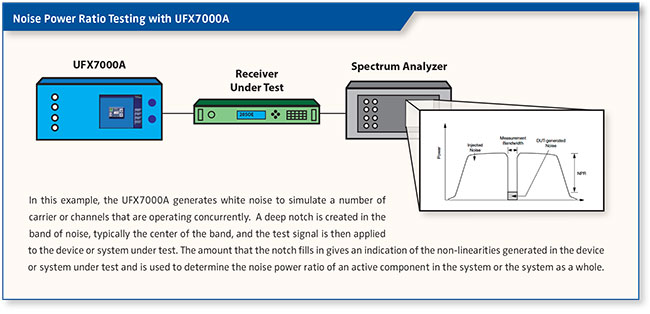
Receiver Reference, Calibration and Performance Test
Noise is an excellent option to be used as a receiver reference or as built-in test equipment (BITE) to evaluate system performance. Switching in a noise source enables the receiver to collect spectral data of its front end and model the system. In these applications noise generation devices are typically packaged as discrete noise diodes (NC100 – NC400), PCB mountable noise modules (NC500) or calibrated coaxial noise sources (NC3000 – NC5000) depending on the level of integration required.
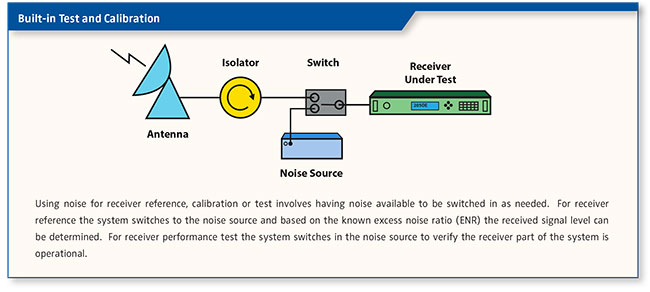
Diodes and Built-in Test Equipment Modules
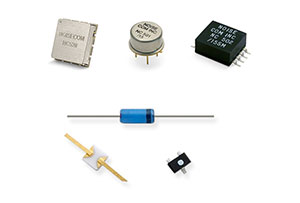 Noise diodes are the fundamental building blocks of analog noise generation and are categorized for performance characteristics that enhance their broadband noise output and flat spectral response. Built-in Test Equipment (BITE) modules are an economical solution for built-in test requirements and contain all necessary bias circuitry and require no external components. The modules have extremely flat output power versus frequency characteristics that are insensitive to temperature and voltage variations.
Noise diodes are the fundamental building blocks of analog noise generation and are categorized for performance characteristics that enhance their broadband noise output and flat spectral response. Built-in Test Equipment (BITE) modules are an economical solution for built-in test requirements and contain all necessary bias circuitry and require no external components. The modules have extremely flat output power versus frequency characteristics that are insensitive to temperature and voltage variations.
UFX7000A Series
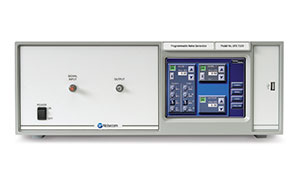 The UFX7000A broadband noise generator has a powerful architecture used to create complex custom noise signals for advanced test systems. This versatile platform allows the user to meet their most challenging design requirements. Precision components provide high output power with superior flatness, and the flexible computer allows control of multiple attenuators, switches, and filter banks. The touch screen streamlines manual control, LAN, GPIB and RS-232 are available for remote control in ATE systems.
The UFX7000A broadband noise generator has a powerful architecture used to create complex custom noise signals for advanced test systems. This versatile platform allows the user to meet their most challenging design requirements. Precision components provide high output power with superior flatness, and the flexible computer allows control of multiple attenuators, switches, and filter banks. The touch screen streamlines manual control, LAN, GPIB and RS-232 are available for remote control in ATE systems.
Specifications
| UFX7000A Series |
Output Characteristics |
| Model |
Frequency Band |
Power |
dBm/Hz (dBm) |
Flatness (dB) |
|
UFX7101A
|
10 Hz - 20 kHz |
+13 |
-30 |
±0.5 |
| UFX7103A |
10 Hz - 500 kHz |
+13 |
-44 |
±0.5 |
| UFX7105A |
10 Hz - 10 MHz |
+13 |
-57 |
±0.5 |
| UFX7107A |
100 Hz - 100 MHz |
+13 |
-67 |
±0.75 |
| UFX7108A |
100 Hz - 500 MHz |
+10 |
-77 |
±1.0 |
| UFX7111A |
1 GHz - 2GHz |
+10 |
-80 |
±1.5 |
| UFX7113A |
10 MHz - 3 GHz |
0 |
-95 |
±2.5 |
| UFX7116A |
10 MHz - 6 GHz |
-12 |
-110 |
±3.0 |
| UFX7128A |
10 MHz - 10 GHz |
-17 |
-117 |
±3.5 |
| UFX7218A |
2 GHz - 18 GHz |
-20 |
-122 |
±2.0 |
| UFX7240A |
2 GHz - 40 GHz |
-20 |
-126 |
±4.0 |
| UFX7900A Series (1 Watt output) |
Output Characteristics |
| Model |
Frequency Band |
Power |
dBm/Hz |
Flatness (dB) |
| UFX7905A |
500 Hz - 10 MHz |
+30 |
-40 |
±2 |
| UFX7908A |
1 MHz - 200 MHz |
+30 |
-53 |
±2 |
| UFX7910A |
2 MHz - 500 MHz |
+30 |
-57 |
±2 |
| UFX7911A |
5 MHz - 1 GHz |
+30 |
-60 |
±3 |
CNG-EbNo
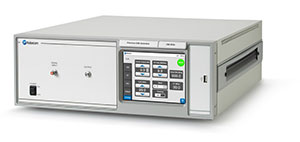 The CNG-EbNo is a fully automated instrument that sets and maintains a highly accurate ratio between a user-supplied carrier and internally generated noise, over a wide range of signal power levels and frequencies. Since the CNG-EbNo automatically compensates for parameters like bit rates and bandwidth, taking measurements is as simple as pressing a button. Operating modes include carrier-to-noise, carrier-to-noise density, carrier-to-interference, bit energy-to-noise density and more. The touch screen streamlines manual control, LAN, GPIB and RS-232 are available for remote control in ATE systems
The CNG-EbNo is a fully automated instrument that sets and maintains a highly accurate ratio between a user-supplied carrier and internally generated noise, over a wide range of signal power levels and frequencies. Since the CNG-EbNo automatically compensates for parameters like bit rates and bandwidth, taking measurements is as simple as pressing a button. Operating modes include carrier-to-noise, carrier-to-noise density, carrier-to-interference, bit energy-to-noise density and more. The touch screen streamlines manual control, LAN, GPIB and RS-232 are available for remote control in ATE systems
Specifications
Operating Modes
| Model Number |
Frequency Range |
Applications |
| CNG-EbNo-70 |
50 to 90 MHz |
General purpose/SATCOM |
| CNG-EbNo-IF1 |
50 to 90 MHz
100 to 180 MHz
|
Intelsat, SATCOM |
| CNG-EbNo-105 |
65 to 75 MHz
50 to 90 MHz
100 to 180 MHz
10 to 200 MHz |
Covers the same noise specs as HP3708A |
| CNG-EbNo-900 |
800 to 1000 MHz |
Cellular |
| CNG-EbNo-750 |
650 to 850 MHz |
Iridium, LTE |
| CNG-EbNo-1550A |
950 to 2150 MHz |
Single Band |
| CNG-EbNo-2050L |
1700 to 2400 MHz |
Cellular/PCS |
| CNG-EbNo-2450 |
2200 to 2700 MHz |
PCS |
| CNG-EbNo-5500 |
5000 to 6000 MHz |
802.11a Wireless LAN |
| CNG-EbNo-20000 |
18 to 22 GHz |
Custom frequency ranges available |
| CNG-EbNo-70/1200 |
50-90 MHz
1120-1280 MHz |
Multiple Carrier Input Capabilities |
| |
-Carrier-to-noise (C/N), carrier-to-noise density (C/No), bit energy-to-noise density (Eb/No), carrier-to-interferer (C/I), noise generator, power meter |
| Carrier Path |
|
| Input power range |
-55 dBm to +5 dBm |
| Maximum input power |
+21 dBm (with no damage) |
| Output power range |
-55 dBm to +5 dBm |
| Nominal gain |
±1.0 dB |
| Gain resolution |
0 to -60 dB in 0.1 dB steps |
| Gain flatness |
±0.2 dB for 70 MHz ±20 MHz
±0.3 dB for 140 MHz ±40 MHz
±0.4 dB for others |
| Group delay |
±0.20 ns/40 MHz for frequencies above 20 MHz |
| Noise Path |
|
| Output power range |
-55 dBm to +5 dBm |
Flatness
±0.2 dB/40 MHz
±0.4 dB/200 MHz |
±0.3 dB/80 MHz
±0.5 dB/300 MHz
|
| Attenuation range |
60 dB (0.1 dB steps) |
| Ratio accuracy |
±0.2 dB RSS, ±0.3 dB WCU |
| Power meter range |
-55 dBm to +5 dBm |
| Power meter accuracy |
±0.5 dB |
| Interferer input |
-4 dBm ±2 dB, frequency range is equal to the noise bandwidth |